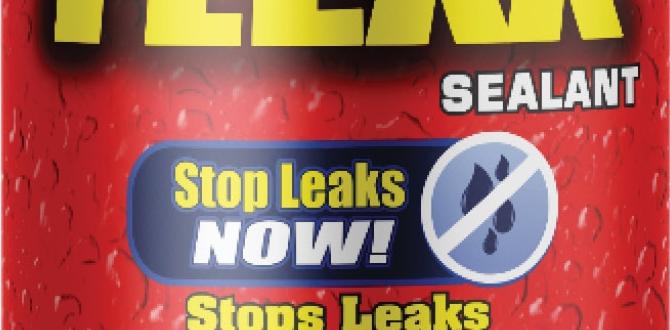Quick Summary:
Proper nail gun maintenance extends tool life, ensures consistent performance, and boosts safety. Following these top 10 tips—from regular cleaning and lubrication to proper storage and air pressure checks—will keep your nail gun firing accurately and reliably for every DIY project.
Hey there, DIYer! Jack Shaffer here, your go-to guy for all things nail guns. Ever had a nail jam, a weak drive, or just a stubborn nailer that won’t cooperate? It’s a common frustration that can halt your project in its tracks. But here’s the good news: most of these issues can be avoided with a little bit of care. Keeping your nail gun in top shape isn’t complicated, and it makes a HUGE difference in how well your tool works and how long it lasts. We’re going to walk through 10 essential maintenance tips that will have your nail gun performing like new. Let’s get those projects back on track!
Table of Contents
Why Nail Gun Maintenance Matters
Think of your nail gun like any other precision tool. It’s full of moving parts that work hard to drive nails quickly and efficiently. Just like a car needs regular oil changes and a saw needs a sharp blade, your nail gun thrives on consistent care. Neglecting maintenance can lead to a cascade of problems:
- Jams and Misfires: Dirt and lack of lubrication are prime culprits for nails getting stuck or not driving properly.
- Reduced Power: A dirty gun might not have the oomph to sink nails flush, requiring you to fire twice or hammer them in manually.
- Inconsistent Performance: One nail might drive perfectly, while the next is only half-in. This is a sure sign something’s off.
- Shortened Lifespan: Worn-out seals, damagedO-rings, and internal wear happen faster when a tool isn’t cared for.
- Safety Hazards: A malfunctioning nail gun, especially one prone to double-firing or misfiring, can be dangerous.
On the flip side, a well-maintained nail gun is a joy to use. It’s reliable, powerful, and safe, making your woodworking projects smoother and more enjoyable. It’s an investment in your tools and your craft.
Top 10 Nail Gun Maintenance Tips
Let’s dive into the practical steps you can take to keep your nail gun in prime working condition. These tips are designed for all types of nailers, from framing and finishing nailers to brad nailers and staplers. We’ll cover everything from a quick daily check to more in-depth care.
1. Keep it Clean, Always
This is arguably the most critical tip. Dirt, sawdust, and debris are the natural enemies of any pneumatic or electric tool. They can gum up moving parts, wear down seals, and cause jams. After every use, and especially before storing your nail gun, give it a good clean.
- Exterior Wipe-Down: Use a dry or slightly damp cloth to wipe down the outside of the tool. Pay attention to the magazine, the nose piece, and the handle area.
- Magazine Cleaning: Gently slide out the magazine (if it detaches easily) and clean any accumulated sawdust or debris. A small brush or compressed air can be helpful here.
- Shooting Nose: The area where the nail exits is prone to getting dirty. Use a soft brush or Q-tip to clean out any residue. Avoid harsh solvents that could damage plastic components.
Consistency here pays off immensely. A quick 30-second wipe-down after each project can prevent hours of troubleshooting later.
2. Lubrication Is Key (For Pneumatic Models)
Pneumatic (air-powered) nail guns have O-rings and seals that need lubrication to function smoothly and prevent air leaks. If you have a pneumatic nailer, add a few drops of specialized pneumatic tool oil regularly. The location for this varies by model, but it’s often:
- At the air inlet: After disconnecting the air hose, apply a few drops directly into the air fitting.
- Via an oil port: Some nail guns have a dedicated oil port, typically near the handle or where the air hose connects.
How often? For heavy-duty use, a few drops daily or every few hours of operation is recommended. For occasional DIY use, once a week or after a significant project is usually sufficient. Check your owner’s manual for specific recommendations. Never use WD-40 or other general-purpose lubricants; they can degrade rubber seals.
What about cordless or electric nailers? These typically don’t require regular oiling at the air inlet as they don’t use compressed air. Their maintenance focuses more on battery care (for cordless) and keeping the motor and firing mechanism clean and free of debris. Always consult your specific model’s manual.
3. Check and Adjust Air Pressure
For pneumatic nailers, the correct air pressure is crucial for both performance and tool longevity. Too much pressure can stress internal components and seals, while too little won’t drive nails effectively.
- Recommended PSI: Most nail gun manufacturers specify a recommended operating pressure range, usually between 70-120 PSI. This is often printed on the tool itself or found in your manual.
- Using a Regulator: Always connect your nail gun to an air compressor equipped with a regulator. This allows you to set and maintain the precise PSI your tool needs.
- Test Drives: After setting the pressure, perform a test drive on a scrap piece of wood. Check if the nails are sinking flush. Adjust pressure up or down in small increments (5 PSI at a time) until you achieve the desired result.
Maintaining the correct pressure also prevents your compressor from overworking and ensures a consistent driver depth.
4. Inspect Nails and Staples for Quality
Using the wrong size or type of fasteners, or even low-quality ones, can cause major issues for your nail gun. Always use the fasteners recommended by the nail gun manufacturer.
- Correct Size and Type: Ensure you’re using the right gauge, length, and collation type (e.g., paper, wire) specified for YOUR nail gun model.
- Straightness: Bent or deformed nails are a recipe for jams. Inspect your nails before loading them into the magazine.
- Cohesion: For collated nails, ensure they are properly glued or wired together. Loose or improperly glued nails can snag and cause feeding problems.
- Avoid Old Stock: Old fasteners can accumulate dust and moisture, which can lead to jams.
Using good quality nails means fewer jams and a cleaner drive. It’s a simple step that saves a lot of headaches.
5. Don’t Force It: Clear Jams Properly
Nail jams happen to everyone. The important thing is how you deal with them. Never try to force a jammed nail out by hammering or prying aggressively, as this can damage the nail gun.
Steps to Clear a Jam:
- Disconnect Power: For pneumatic, disconnect the air hose. For cordless/electric, remove the battery or unplug it. Safety first!
- Inspect the Nose: Look into the nose of the gun to see where the nail is jammed.
- Remove Obstructions: Most nail guns have a nose plate or cover that can be removed (check your manual). This gives you better access.
- Gentle Extraction: Use needle-nose pliers or tweezers to carefully pull out the jammed nail. If it’s only slightly bent, you might be able to extract it without disassembling anything.
- Reassemble and Test: Once the jam is cleared, reassemble any parts you removed and re-apply power. Fire into scrap material to ensure it’s working correctly before returning to your project.
A little patience here goes a long way in preventing damage.
6. Inspect and Clean the Magazine
The magazine is where your nails are stored and fed into the firing chamber. If it’s clogged with debris or bent, it will cause feeding issues.
- Regular Cleaning: As mentioned in tip #1, keep this area clean. Sawdust and wood shavings can accumulate and prevent nails from sliding smoothly.
- Check for Damage: After cleaning, inspect the magazine for any dents, bends, or cracks. A damaged magazine can misalign nails, leading to jams.
- Lubricate (Sparingly): Some manufacturers suggest a very light application of lubricant on the magazine track if nails are sticking. Use sparingly and only if recommended in your manual, as too much can attract more dust.
A smooth-feeding magazine is essential for continuous nailing. You want it to slide freely and guide nails accurately.
7. Store Your Nail Gun Properly
Where and how you store your nail gun can significantly impact its condition. Proper storage prevents dust accumulation, protects from damage, and keeps it ready for your next use.
- Clean and Dry: Always ensure the gun is clean and completely dry before storing.
- Protect from Elements: Store in a location that isn’t excessively humid, dusty, or exposed to extreme temperatures. A toolbox, a dedicated case, or a clean shelf in your workshop is ideal.
- Air Pressure (Pneumatic): For pneumatic nailers, it’s generally recommended to store them with a small amount of air pressure in the internal cylinder. This helps keep the seals lubricated and prevents them from drying out. However, some experts recommend releasing pressure for long-term storage to prevent slow leaks. Consult your manual!
- Battery Storage (Cordless): For cordless nail guns, store batteries according to the manufacturer’s instructions, usually at room temperature and not fully discharged or fully charged for very long periods.
A dedicated case is often the best option, protecting the tool from dust, impact, and theft.
8. Check for Air Leaks
For pneumatic nailers, air leaks are more than just an annoyance; they reduce efficiency and can lead to the compressor running more often than necessary.
- Listen Carefully: After disconnecting the air hose, listen for any hissing sounds. The most common culprits are the O-rings in the trigger assembly, magazine, or nose.
- The Soap Test: If you suspect a leak, disconnect the air supply, then mix a little dish soap with water in a spray bottle. Spray the suspect areas. If bubbles form, you have a leak.
- Tighten Fittings: Sometimes, a leak can be as simple as a loose air fitting. Ensure all connections are snug.
- Address Issues: Minor leaks around seals might be temporarily fixed with specialized lubricants, but persistent leaks usually require replacing O-rings or seals. This is a job your manual will guide you on, or consider a tool repair shop.
Fixing leaks ensures your nail gun operates at peak efficiency and your compressor works smarter, not harder.
9. Consider an Air Line Lubricator (Pneumatic Only)
For those who use pneumatic tools frequently or for demanding tasks, an in-line air line lubricator can be a game-changer. This device is installed in the air hose between the compressor and the nail gun.
- How it Works: It injects a fine mist of pneumatic tool oil into the air stream, lubricating all the internal components of the nail gun as you work.
- Benefits: This provides consistent lubrication, extending the life of internal parts, seals, and O-rings, and can help prevent rust and corrosion, especially in humid environments.
- Setup: You’ll need to fill the lubricator reservoir with specialized pneumatic tool oil and adjust the setting to ensure the right amount of oil is delivered.
If your nail gun sees heavy use, investing in an air line lubricator can be a proactive step towards maximizing its lifespan and performance.
10. Read Your Owner’s Manual!
This might sound basic, but it’s often overlooked. Every nail gun, even within the same brand and type, can have unique maintenance requirements.
Your owner’s manual is the ultimate guide to:
- Specific lubrication points and schedules (if any).
- Recommended types of fasteners.
- Recommended operating air pressure ranges.
- Troubleshooting common issues specific to your model.
- Instructions for disassembly and reassembly for cleaning or repair.
- O-ring and seal part numbers (if applicable).
Don’t have it? Most manufacturers offer downloadable PDFs of their manuals on their websites. Taking 15 minutes to familiarize yourself with your tool’s specific needs is a small price to pay for its long-term health.
Nail Gun Maintenance Checklist
To help you keep track, here’s a handy checklist you can print or save:
| Maintenance Task | Frequency (General) | Notes |
|---|---|---|
| Clean Exterior and Magazine | After Each Use | Wipe down, use brush/air for magazine. |
| Lubricate Pneumatic Nailer | Daily (Heavy Use) / Weekly (Light Use) | Use specific pneumatic tool oil at air inlet/port. |
| Inspect Fasteners | Before Each Loading | Check for damage, correct size. |
| Check Air Pressure (Pneumatic) | Before Each Use | Set to recommended PSI using regulator. |
| Inspect for Air Leaks (Pneumatic) | Monthly / If performance drops | Listen for hissing, use soap test if needed. |
| Deep Clean Internals | Annually / If performance drops significantly | Follow manual for disassembly if comfortable, or seek professional help. |
| Check Firing Nose for Debris | Periodically | Ensure it’s clear for proper nail seating. |
| Inspect Magazine for Damage | Quarterly | Check for dents or bends that affect feeding. |
| Battery Health Check (Cordless) | Monthly | Ensure proper charging and storage for battery life. |
This table provides a good starting point. Always defer to your specific tool’s manual for the manufacturer’s recommendations. For professional-grade tools that see daily, heavy use, more frequent maintenance is often advised. You can find great resources for general tool care on sites like Tooling.com or industry publications.
Common Nail Gun Maintenance Questions: FAQ
Q1: How often should I lubricate my nail gun?
For pneumatic nailers, if you use it daily, a few drops of oil at the air inlet each day is ideal. For occasional DIY use, lubricating once a week or after a large project should suffice. Always use specific pneumatic tool oil, not general lubricants like WD-40, as they can damage rubber seals. Refer to your manual for exact recommendations.
Q2: What kind of oil should I use for my pneumatic nailer?
You should use a specialized pneumatic tool oil. These oils are formulated to be compatible with the rubber and plastic components found inside nail guns and to provide proper lubrication without degradation. You can find this oil at most hardware stores or online tool suppliers.
Q3: My nail gun is jamming frequently. What’s likely the cause?
Frequent jamming is usually due to a few common issues: using the wrong type or quality of nails, a dirty magazine or firing mechanism, insufficient air pressure, or worn-out O-rings and seals. Start by ensuring you’re using the correct, high-quality fasteners and cleaning the gun thoroughly. If the problem persists, inspect the magazine and consider checking air pressure and internal components.
Q4: Can I use my nail gun in cold weather?
Yes, but with caution. Extreme cold can affect the performance of pneumatic tools. Lubricants can thicken, and seals can become less pliable, potentially leading to leaks or reduced power. If you must use your nail gun in cold conditions, keep it indoors until just before use, and consider using a heavier-grade pneumatic oil if recommended by the manufacturer. Allow the tool to warm up slightly before extensive use.
Q5: How do I clean the internal parts of my nail gun?
Most manuals provide instructions for a basic internal cleaning, often involving removing the nose assembly. For a deeper clean, you might need to disassemble parts of the cylinder and piston. If you’re not comfortable with mechanical disassembly, it’s best to take it to a professional tool repair service. Always disconnect power before attempting any internal cleaning.
Q6: My cordless nail gun battery isn’t holding a charge. What can I do?
For cordless nail guns, battery issues are common. First, ensure you are using the correct charger and that it’s functioning properly. Clean the battery contacts on





